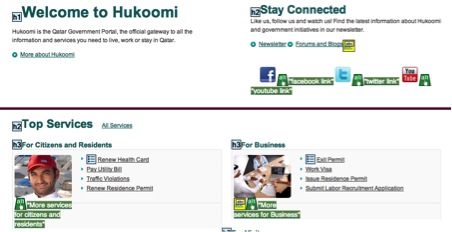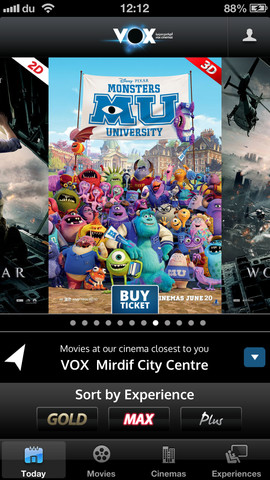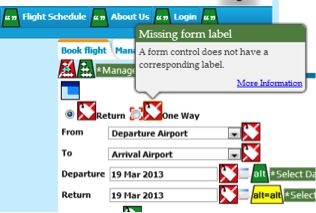The following is a contributor post from Chris Rourke, MD of User Vision.
Accessible Arabia Part 2 – Putting accessibility on the agenda
 In Part 1 of this article we pointed out that whilst accessibility is important, it is often not part of the conversation between agencies and clients, and as a result it is often not built in to the resulting website.
In Part 1 of this article we pointed out that whilst accessibility is important, it is often not part of the conversation between agencies and clients, and as a result it is often not built in to the resulting website.
In this concluding part we will briefly cover
- Ways to get accessibility on the agenda for your organisation and in the Arab region
- Some good examples of accessibility being implemented and
- The best resources to learn more about web accessibility
Getting the accessibility ball rolling
The best way to start a programme to improve your site accessibility is to have a close look at the current state of your site’s accessibility. Although web accessibility is closely tied in with the coding of your site, you do not need to be a coder or developer to start to detect some of the accessibility problems.
As demonstrated in the Part 1 article, there are some simple and useful tools that can help you assess your site’s accessibility. My personal favourite is the WAVE tool from WEBAIM but other good ones are the Web accessibility Toolbar from Vision Australia, and there are others.
These can be used to find some of the “low hanging fruit” issues – the accessibility risks that can be picked up by an automatic programme or spider. This will not find a full and complete set of issues but it will be a good start for finding things such as missing alt text, problems in forms, or poor colour contrast. These can be presented in a easy, visual style and allow you to drill down to learn more about the nature of each problem and more importantly the steps needed to solve it.
Another good way to find accessibility problems is to test the site with people that have disabilities. For instance this could include those with visual impairments or alternatively this could be physical or cognitive disabilities. Although there will be some extra effort to arrange a short usability test with this audience, the benefit will be strong empirical evidence which really makes it clear where the main barriers lie.
Getting accessibility built into sites in the region
A few years ago we conducted a project for the government of Abu Dhabi that gave us a good insight into the state of web accessibility in the UAE and the region as a whole. It showed that the standard of web accessibility in the Middle East is generally lower than in most other parts of the world, especially when comparing high profile sites such as government departments or large banks.
Why are these otherwise professional and high profile sites so inaccessible?
Are there users with disabilities that want to book their own flight, access eGovernment information or access information online? Absolutely.
Is there a strong motivation for these organisations to improve the accessibility provisions on their sites? Not really.
The situation can improve, but it needs more than guidelines in web accessibility which I will outline later.
The underlying problem is that there is no web accessibility “market” in the Middle East. Areas where web accessibility has made better progress, such as in the UK, have largely benefitted from the push and pull forces of a market.
The web Accessibility “Market forces”
 The market is quite simple and the critical elements of this are listed below, starting with the most important stakeholder – the users.
The market is quite simple and the critical elements of this are listed below, starting with the most important stakeholder – the users.
- Disabled users need to be aware of their right to e-accessibility and demand it. The need for digital accessibility and the benefits it brings should be raised by individuals and through disability-related organisations. Government and non-governmental organisations (NGOs) can support this effort.
- Companies and organisations with websites need to hear of this demand and at the same time be made aware of the benefit of improving accessibility. They then need to demand that it is built into the design and maintenance of their sites, whether that happens in-house or through external agencies. Stipulating compliance with WCAG 2.0 or national guidelines will not solve the problem overnight, but it will focus the minds of supplier agencies.
- Digital agencies need to see this as an opportunity to gain a competitive advantage. They can shout about how they can create accessible sites, but must be sure they can walk the walk as well as talk the talk. They can build an accessibility competence in house or with specialist partners and raise the accessibility issue to their clients and keep it in the site development and maintenance plan.
These actions by these three key stakeholders will start the ball rolling and ideally create a “virtuous circle” of ever increasing accessibility online.
To a large degree this combination of increased awareness and pressure on other stakeholders in the market has driven the improvements in accessibility within the UK, and there is no reason why it could not occur in the Middle East.
Regional examples of web accessibility
Having pointed out some regional examples of poor accessibility it is only fair to give credit where things are being done right. Perhaps the highest profile examples are those from the government of Qatar. Qatar has set up a centre of excellence in web accessibility called MADA that has set itself the goal of making all the eGovernment channels in Qatar as accessible as possible. As a result there is a high level of accessibility in the Qatar government websites.
For example on the Qatar government eServices Portal Hukoomi it is clear that accessibility has been addressed. The image below shows the content area of the page assessed through the WAVE tool and there is good structural markup (Headings H1, H2, H3) and accurate alternative test on the images.
The same level of accessibility continues throughout the site, including the transactional areas with forms, a typical trouble spot for web accessibility.
Resources: Learning about web accessibility
One thing that is definitely NOT a reason for overlooking accessibility is a lack of guidance about how to create an accessible site. There is plenty of great guidance out there, ranging from the official WCAG 2.0 guidelines to slightly less formal from organisations such as the RNIB in the UK or WEBAIM in the US.
A final thought on web accessibility. Its helps people use the web as it was intended, regardless of their disabilities. In the long run, as we age and collect various impairments, every one of us could benefit from this.
About Chris Rourke
 Chris Rourke is the Managing Director of User Vision MENA, the Middle East’s leading user experience research and design agency.
Chris Rourke is the Managing Director of User Vision MENA, the Middle East’s leading user experience research and design agency.
With over 20 years’ experience in usability, accessibility and experience design, Chris has worked with leading brands in the region including Emirates Airline, Jumeirah Group, and the Government of Abu Dhabi, as well as many others in the UK and Europe.
He has led projects at all stages of the user-centred design life-cycle from user needs research through to development of information architecture, usability testing and on-going user experience research.
Chris enjoys sharing his enthusiasm for user experience and provide training on user experience through Twofour54 and Econsultancy as well as in-house training courses.















